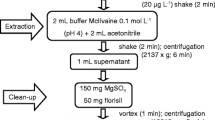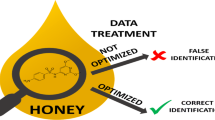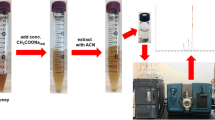Abstract
In the framework of developing analyses for exogenous contaminants in food matrices such as honey, we have compared data obtained by high-performance liquid chromatography coupled with mass spectrometry (LC–MS) to those provided by high-performance liquid chromatography and tandem mass spectrometry (LC–MS–MS). Initial results obtained with LC–MS showed that the technique lacked selectivity, which is why the method was validated by LC–MS–MS. This method involves a solid-phase extraction (SPE) of nitrofuran metabolites and nitrofuran parent drugs, a derivatization by 2-nitrobenzaldehyde for 17 h, and finally a clean-up by SPE. The data obtained show that the limits of detection varied between 0.2 and 0.6 μg kg−1 for the metabolites and between 1 and 2 μg kg−1 for nitrofuran parent drugs. The method was applied to different flower honeys. The results showed that nitrofurans (used as antibiotics) are consistently present in this matrix, the predominant compound being furazolidone.

Working bees




Similar content being viewed by others
References
Khong SP (2004) J Agric Food Chem 52:5309−5315
Jenkins KM, Young MS (2005) The applications book. Waters, MA, pp 19–20
EC (1990) Off J Eur Commun L224:1–6
Hoogenboom LAP (1991) Food Chem Toxic 29:321–328
Draisci R (1997) J Chromatogr A 777:201–211
Galeano Díaz T (1997) J Chromatogr A 764:243–248
Hoogenboom LAP (1992) Food Addit Contam 9: 623–630
Horne E, Cadogan A, O’Keeffe M, Hoogenboom LAP (1996) Analyst 121:1463–1468
McCracken RJ, Glenn Kennedy D (1997) J Chromatogr B 691:87–94
Hormazábal V, Tone N (2004) J Liq Chromatogr RT 27:2759–2770
Leitner A, Zöllner P, Lindner W (2001) J Chromatogr A 939:49–58
Edder P, Vargas S, Ortelli D, Corvi C (2003) Clin Chem Lab Med 41:1608–1614
Pereira AS, Pampana LC, Donato JL, De Nucci G (2004) Anal Chim Acta 514:9–13
Cooper KM, Glenn Kennedy D (2005) Analyst 130:466–468
Feinberg M (2001) Tech Ing Anal Caractér P224:1–23
Author information
Authors and Affiliations
Corresponding author
Rights and permissions
About this article
Cite this article
Tribalat, L., Paisse, O., Dessalces, G. et al. Advantages of LC–MS–MS compared to LC–MS for the determination of nitrofuran residues in honey. Anal Bioanal Chem 386, 2161–2168 (2006). https://doi.org/10.1007/s00216-006-0878-3
Received:
Revised:
Accepted:
Published:
Issue Date:
DOI: https://doi.org/10.1007/s00216-006-0878-3




